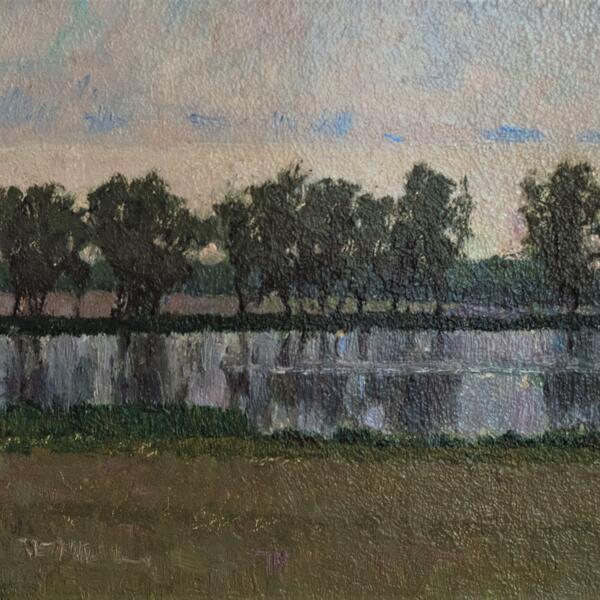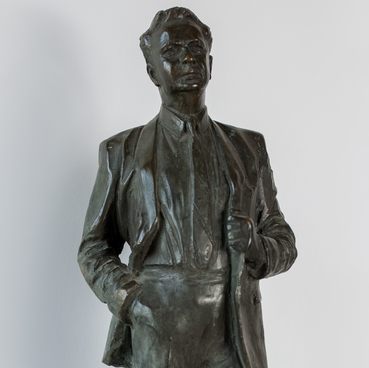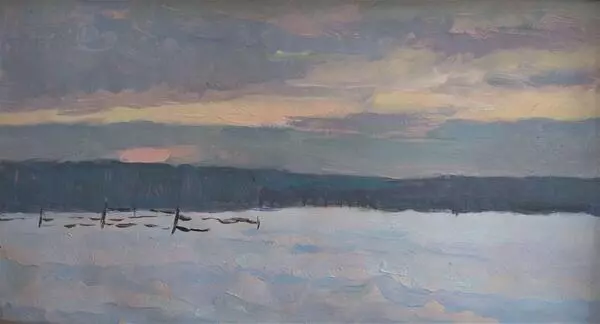The work “Pond Behind the Timiryazev Academy” from the collection of the Volzhsk Art Gallery was painted by an artist Serafim Zverev in 1934. He depicted the Big Garden Pond, one of the favorite vacation spots of Moscow residents, as well as the scientific ground of the main agrarian institute of the USSR.
Zverev painted a simple spring landscape. The foreground shows verdant fresh grass, in the background, there is a strip of water with trees reflecting in it. The opposite shore with an avenue of trees is depicted in the background. The pale blue sky complements the composition.
In 1940, by order of the Council of People’s Commissars of the USSR, the area of the K.A. Timiryazev Agricultural Academy, where the pond was located, was declared a nature reserve. This helped to protect the pond from pollution and shoaling.
Serafim Zverev developed a penchant for drawing and painting as a child, when he lived with his mother Mariya and his father, the priest Alexander, in Bethany, a picturesque place near Sergiev Posad. When Serafim was young, as the artist recalled, his mother used to draw for him “small scenes from Russian fairy tales. She was not a professional artist, despite having studied at the Stroganov School, but in her free time liked to paint studies from life. It was his mother who first introduced him to art.”
In the summer of 1918, the Zverevs moved to Moscow. During his school years, Serafim received a gift — a large hardcover notebook, where he would draw everything he saw. In 1928, through his father, he met Mikhail Nesterov, a painter, member of the Association of Traveling Exhibitions and the Association “World of Art”. He strongly objected to Zverev’s earlier works, nevertheless, he asked his student Pavel Korin to teach the boy.
Soon Zverev graduated from the school, as well as trading courses, engaged in the stock exchange and later started training for a new occupation. He graduated from the masonry department of the Central Institute of Labor and became a 2nd-class bricklayer. Zverev worked at a construction site for more than a year, engaging in painting only occasionally. In 1932, he graduated from the Industrial and Economic Combine as a detail drafter.
During this period, he worked as a professional painter: he decorated the city for holidays, columns of demonstrators for May 1 and the October Revolution Day, as well as created great portraits ordered by Moscow district committees and worked at factories. In 1936, Zverev participated in his first exhibition, and for several years he worked on copies of paintings by Mikhail Nesterov, Ilya Repin, and Vasily Surikov, including for traveling exhibitions at the Tretyakov Gallery.
The landscape genre always had a special place in Zverev’s heart. In the 1930s — 1940s, he painted outdoors only, striving to convey the impressions of nature with his studies. The painting “Pond Behind the Timiryazev Academy” also belongs to this period. In the 1950s, Zverev switched to complex landscapes, which were often composed of parts from his other studies. Over time, he began to work on monumental landscapes and completely abandoned plein air painting.
Zverev painted a simple spring landscape. The foreground shows verdant fresh grass, in the background, there is a strip of water with trees reflecting in it. The opposite shore with an avenue of trees is depicted in the background. The pale blue sky complements the composition.
In 1940, by order of the Council of People’s Commissars of the USSR, the area of the K.A. Timiryazev Agricultural Academy, where the pond was located, was declared a nature reserve. This helped to protect the pond from pollution and shoaling.
Serafim Zverev developed a penchant for drawing and painting as a child, when he lived with his mother Mariya and his father, the priest Alexander, in Bethany, a picturesque place near Sergiev Posad. When Serafim was young, as the artist recalled, his mother used to draw for him “small scenes from Russian fairy tales. She was not a professional artist, despite having studied at the Stroganov School, but in her free time liked to paint studies from life. It was his mother who first introduced him to art.”
In the summer of 1918, the Zverevs moved to Moscow. During his school years, Serafim received a gift — a large hardcover notebook, where he would draw everything he saw. In 1928, through his father, he met Mikhail Nesterov, a painter, member of the Association of Traveling Exhibitions and the Association “World of Art”. He strongly objected to Zverev’s earlier works, nevertheless, he asked his student Pavel Korin to teach the boy.
Soon Zverev graduated from the school, as well as trading courses, engaged in the stock exchange and later started training for a new occupation. He graduated from the masonry department of the Central Institute of Labor and became a 2nd-class bricklayer. Zverev worked at a construction site for more than a year, engaging in painting only occasionally. In 1932, he graduated from the Industrial and Economic Combine as a detail drafter.
During this period, he worked as a professional painter: he decorated the city for holidays, columns of demonstrators for May 1 and the October Revolution Day, as well as created great portraits ordered by Moscow district committees and worked at factories. In 1936, Zverev participated in his first exhibition, and for several years he worked on copies of paintings by Mikhail Nesterov, Ilya Repin, and Vasily Surikov, including for traveling exhibitions at the Tretyakov Gallery.
The landscape genre always had a special place in Zverev’s heart. In the 1930s — 1940s, he painted outdoors only, striving to convey the impressions of nature with his studies. The painting “Pond Behind the Timiryazev Academy” also belongs to this period. In the 1950s, Zverev switched to complex landscapes, which were often composed of parts from his other studies. Over time, he began to work on monumental landscapes and completely abandoned plein air painting.





